|
BERDAN’S SHARPSHOOTERS MODEL 1859 NEW MODEL SHARPS
RIFLE – AN EXCELLENT EXAMPLE OF THIS HISTORICALLY
IMPORTANT RIFLE WITH ALL OF THE RECOGNIZED FEATURES OF A
BERDAN’S SHARPS RIFLE: This is an excellent
specimen of the Model 1859 Sharps Rifles which were
specifically made for, and issued to, the famous 1ST
and 2ND United States Sharpshooter Regiments
organized by Colonel Hiram Berdan in 1861 and 1862.
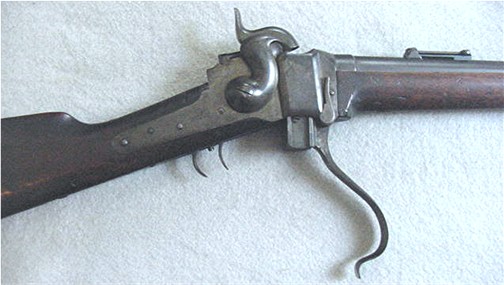
Hiram Berdan, born in Phelps, New York on September 6,
1824, was working in New York City at the onset of the
Civil War. By the 1850’s he had become widely
recognized as an inventor and as a talented civil and
mechanical engineer, with such inventions to his credit
as mechanical baking ovens, dough kneading machines, and
collapsible lifeboats. His most notable invention, and
the one on which he built his personal fortune, was not
the firearms cartridge primer design which still bears
his name, but rather a simple wrought iron pan which
held several cast iron balls. He secured a patent for
this simple device in 1853, and it became known as
“Berdan’s Gold Quartz Ore Amalgamator”, revolutionizing
the method for extracting gold from raw ore in the
California Gold Fields.
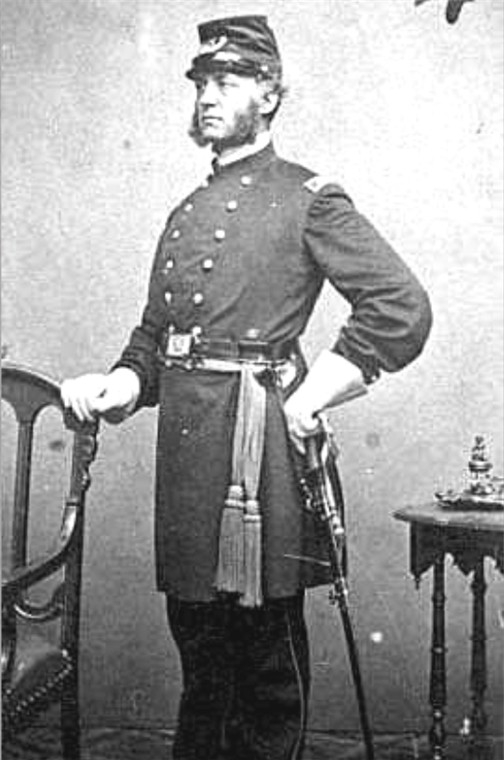
Colonel Hiram Berdan
In addition to the fame he earned for his inventions,
Berdan had also been recognized as one of the nation’s
greatest marksmen dating back to the mid-1840’s.
Numerous newspaper articles reported his skill with
muzzle loading percussion target rifles, to the extent
that his reputation as an accomplished marksman was well
established.
While some writers have characterized Berdan’s concept
of a regiment of sharpshooters as a revolutionary step
in the field of military science and tactics, in fact
the value of riflemen applying concentrated, directed,
well aimed fire against the enemy had been recognized
long before the Civil War. Dating back to before the
American Revolution, only the most intransient or
foolhardy officers discounted such marksmanship as
anything but a very real threat to their safety. The
ability of well trained riflemen to inflict substantial
casualties among individual officers, senior NCO’s and
artillery men, thereby compromising the enemy’s ability
to prosecute an attack, was only limited by the length
of time necessary to reload the muzzle loading rifles –
considerably more time consuming than reloading the
smooth bore muskets carried by regular infantrymen. And
too, especially in North America, in general terms the
graceful design of most rifles, the lack of a bayonet,
and the wide variation in calibers made the rifle more
operationally problematic on the battlefield than was
the more robust standard issue musket.
Berdan embraced this concept when he began to advertise
recruiting events in each state which would allow him to
hand select the finest marksmen from those who applied
through competitive shooting trials. From those
selected, he formed two regiments, ten companies to the
regiment, with an intended 100 men per company. Whether
or not he ever met his manpower goals of 1,000 men per
regiment at any one time has been debated, but he
certainly recruited enough skilled marksmen to support
the two regiments with one estimate numbering 1,750 men
in the original enlistment. In addition to establishing
minimum standards of marksmanship, Berdan also provided
instruction in estimating distances, adjusting the
aiming point when firing up or down an incline, and
compensating for the wind – all skills still being
taught in long range shooting schools. Berdan titled
these units the First Regiment of United States
Sharpshooters, and the Second Regiment of United
States Sharpshooters. President Lincoln was so
impressed with Berdan’s idea and his efforts that he
authorized the two regiments be brought into federal
service.
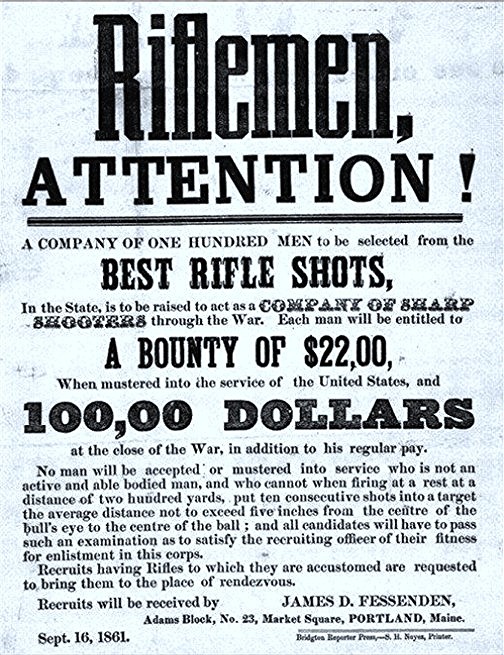
The First Regiment of US Sharpshooters was mustered into
service on August 1, 1861, and over the course of the
next twenty eight months, approximately 1,388 men
enlisted on the rolls. The regiment was actively
engaged with the Army of the Potomac, present at such
battles as the Peninsular Campaign, the Second Manassas,
Antietam, Chancellorsville, Gettysburg, The Wilderness,
Spotsylvania, Cold Harbor, and the Siege of Petersburg.
The Second Regiment of US Sharpshooters, also
incorporated into the Army of the Potomac, was mustered
into service on October 4, 1861, with some 1,132 men
serving the regiment over the next forty plus months,
writing a unit history as impressive as that recorded by
the First Regiment. Due to the manner in which these
soldiers were intended to be used, they were seldom
deployed on the battlefield in regimental order; rather
they were allocated in smaller units to address specific
targets or to interrupt evolutions or maneuvers by enemy
forces.
One notable example of the effectiveness of the
Sharpshooters occurred during the Battle of Gettysburg.
On the morning of July 2, 1863 a small detachment of
Sharpshooters was sent forward and deployed in the path
of Confederate General Longstreet’s advance. In the
course of the day, Berdan’s green clad soldiers under
the command of Lieutenant Colonel Trepp, expended more
than 14,400 rounds of ammunition, inflicting what
Longstreet later described as “heavy causalities”,
causing Longstreet to delay his advance and eventually
withdraw. This delay prevented the Confederate forces
from securing the Peach Orchard, and more importantly
kept those forces from attaining the superior positions
on Big and Little Round Top.
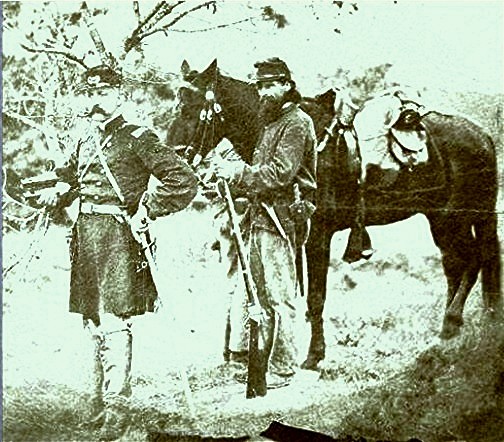
Colonel Hiram Berdan with famed Sharpshooter, Truman
("California Joe") Head
When Berdan first organized his regiments, even though
he had assembled a very skilled body of marksmen, they
continued to labor under the same limitations
experienced by similar units in the past. Berdan’s men
entered the war armed with a variety of single shot,
muzzle loaded target rifles, manufactured for the
shooting bench and not for the battlefield, in a wide
variety of calibers – some bored for unique calibers
which rendered them virtually worthless without the
custom made bullet mold originally supplied with the
rifle. Of course, these rifles had no provision for
mounting a bayonet. Reloading was still a slow process
which often exposed the shooter, thus negating any
advantage he would have enjoyed by remaining concealed,
and maintaining a steady supply of ammunition to the
soldiers in the field continued to be a problem.
The Sharps Rifle Company was well established by the
time hostilities erupted in 1861. Sharps rifles and
carbines were well respected as hardy and reliable
firearms, having been sorely tested throughout the West
in the hands of immigrants, hunters, miners flocking to
the gold fields, and of special note, they were favored
by US Army dragoons and cavalrymen over all the other
models of carbines and rifles then being issued to the
troops in the antebellum years. Based on this proven
record of performance, in 1861 the US Army Ordnance
Department secured a contract with Sharps to purchase
virtually the company’s entire production of military
style firearms for the foreseeable future.
Berdan reached the same conclusion when he settled on
the Model 1859 “New Model” Sharps Rifle - a robust, well
built, accurate firearm, designed and engineered for
heavy use in a demanding environment – as the rifle
which would resolve all of the firearms related issues
which were plaguing his regiments. The breech loading
design was easily reloaded without the soldier exposing
his position and it was capable of maintaining an
impressive rate of sustained fire. Further, the rifle
used a standard cartridge and priming system already in
production and readily available through the army’s
supply system.
The “only” obstacle he faced in securing these rifles
was to finagle an interruption of the Sharps Company’s
effort to meet the Ordnance Department’s demands – no
small feat when every unit in the army was clamoring for
new arms. Berdan negotiated the hallways of power and
with the intercession of President Lincoln and the
Secretary of War he secured a commitment from Sharps to
provide 2,000 Model 1859 Rifles to his two regiments.
Any other colonel focused
on arming his regiment at that time would have been more
than satisfied with this result. No so, Col. Berdan.
He pressed forward by specifying that Sharps incorporate
features which were not standard on the rifles currently
under production, further confounding Sharps’ efforts to
meet their standing contract with the Ordnance
Department. Berdan required his rifles be fitted with
double set triggers, a lock fitted with a fly on the
tumbler, that the lever latch be omitted, and finally
that they be fitted with a socket angular bayonet of the
standard pattern in use by the regular infantry
regiments. Berdan prevailed, his requirements were met,
and the 2,000 rifles were delivered.
Not only did these added features increase the efficacy
of the rifles in the hands of Berdan’s Sharpshooters,
but these very same features had the unintended benefit
of making this lot of historic rifles unique. The
combination of these features, and the additional
inspectors’ stamps which were applied to the rifles in
this special order, have enabled modern collectors to
positively identify Berdan’s Sharps Rifles from the
other Sharps rifles of the period.
The first delivery of Berdan Sharps Rifles was made on
April 11, 1862 and the last lot was delivered on May 24TH,
with the shipments being allocated to the two regiments
presumably in equal parts, and directed to Fort Monroe
in Hampton, Virginia for the 1ST Regiment and
to the Washington Arsenal for the 2ND
Regiment. The rifles were then issued beginning on May
8, 1862 to the 1ST Regiment while they were
at Yorktown, Virginia. The 2ND Regiment
received their issue of rifles beginning on June 6,
1862, at Fredricksburg, Virginia.
Considering that the war was in its first year – not yet
a full 12 months since the first shots of the war were
fired on Fort Sumter - with all the attendant demands on
available manpower, arms, and equipment which the
mobilization entailed, that Berdan was able to obtain
approval to recruit his two regiments, and then train
them, design, produce and issue their distinctive green
uniforms, and that his special order rifle of a unique
configuration was approved, financed, manufactured, and
delivered as quickly as it was, is quite a remarkable
feat of logistics.
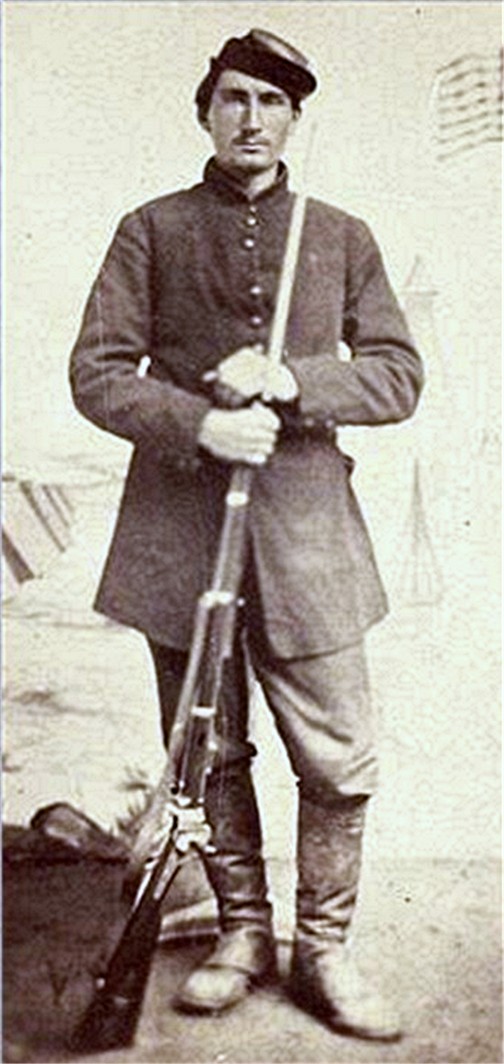
PRIVATE
SHERROD BROWN Co. F,
1ST
U.S. SHARPSHOOTERS REGIMENT
The two most often cited serial number ranges have been
provided by Wiley Sword – between 54412 and 57567, and
by Roy Marcot – between 54,374 and 57,574. A third
researcher who was collecting serial numbers from rifles
which met the criteria of the Berdan’s Sharps expanded
the lower end of the range to 41576 while indicating
that the highest number he had recorded was 56,900. All
three researchers agree on the characteristics of the
Berdan Rifles such as featuring the double set triggers,
the lack of the lever latch, and that they were fitted
for the angular socket bayonet.
The serial number of this rifle – 56211 – is legibly
stamped on the upper receiver tang, with the same
matching number stamped on the underside of the barrel.
This serial number falls well within the recognized
range of serial numbers of the Sharps Rifles issued to
Berdan’s regiments of sharpshooters. While this
specific number does not appear in any of the known or
published lists of Berdan’s Sharps, those lists are far
from being comprehensive and they account for relatively
few of the total of 2,000 rifles issued to the two
regiments. Worthy of note, this serial number falls
between two confirmed Berdan Sharps Rifles - serial
numbers 56113 and 56219 – recorded on the list published
by Wiley Sword.
While I had the fore arm removed to photograph the
barrel serial number, I noticed an unusual feature that
is definitely an added value to this rifle. The fit of
the fore arm to the barrel was so well executed that the
serial number stamped on the barrel left an impression
in the corresponding section of the fore arm’s barrel
channel, resulting in a mirror image of the serial
number in the wood. The numbers impressed into the wood
present in reverse of the serial numbers stamped on the
barrel, the numerals in the wood matching the exact
location of the numerals on the barrel. While Sharps
did not intend for there to be a serial number stamping
on the fore arm, this mirror image of the barrel
stamping confirms that this fore arm is indeed original
to this rifle.
Through the efforts of
several researchers through the years, a well documented
and widely accepted profile of the Berdan Sharpshooter
Model 1859 New Model Sharps Rifle has been established
which enables collectors to positively identify the
rifles issued to the 1ST and 2ND
Regiments of U.S. Sharpshooters. All of these
recognized unique characteristics are present on this
rifle, to include:
1. The “JT” cartouche,
applied by Ordnance Department inspector John Taylor on
the left flat of the stock
that lies between the wrist and the receiver.
2. The “OWA” initials of
Ordnance Department inspector Orville W. Ainsworth
stamped on the left barrel flat forward of the
receiver. The “Berdan Sharps” are the only Model 1859
Sharps Rifles which bear this particular inspector’s
stamp.
3. Double
set triggers. A design known as a single stage set
trigger – i.e. the rear trigger must be set prior to
cocking the hammer, and the front trigger will only fire
the rifle if it is set prior to cocking the hammer.
This was a well accepted design which had been
incorporated in the early long and plains rifles,
especially on those rifles most recently made famous
during the fur trade and western expansion eras by the
Hawken Brothers and Dimick in St. Louis. This
design simplified the manufacture of the mechanism
and in use, reduced the chance for a failure. The net
effect of a set trigger over a standard trigger was to
lighten the pressure required to release the sear and
fire the rifle, which in turn facilitated the accuracy
of the shot.
4.
No lever latch. Berdan eliminated
the sliding spring loaded latch which engaged the
rear tip of the loading lever and held it closed.
5. A little known feature
of these rifles is the pin punch stamp which was struck
on the interior face of the patch box lid as the final
inspection and acceptance mark applied by John Taylor,
the government inspector assigned to the Sharps Rifle
Company factory.
6 . 30” barrel fitted with
a square front sight base which served to mount the
triangular socket bayonet rather than the sabre
bayonet Sharps offered with some other models of their
military rifles.
This rifle has survived in remarkably very good to
excellent condition. Within the context of having been
in the hands of Berdan’s Sharpshooters, it shows
evidence of having been issued and subjected to service
in the field, however without any signs of abuse,
neglect or poor storage.
The surface of the barrel is overall smooth
with a pleasing even blue
turning to plum brown color. The original bright blue
finish is still present under the forearm.
The barrel bands still
retain quite a bit of the original blue finish.
The bore is excellent, clean and bright throughout with
only some light frosting on the breech end, but no dark
patches or distinct pitting. The lands and grooves are
distinct for the full length of the bore.
The receiver, breech block, lever, trigger plate, patch
box assembly, and butt plate all retain visible traces
of the original case color patterns. The interior of
the patch box lid shows some faded and mottled case
colors, as well as the proper pin punch stamp.
The muzzle end of the exterior surface of the barrel has
some very minor isolated pitting. As the pitting is
limited to this area of the barrel and did not extend
into the balance of the length, it suggests that this is
where the soldier grasped the barrel when the butt was
resting on the ground. Another possibility suggests
that the rifle may have been carried balanced across the
soldier’s shoulder - butt to the rear while he grasped
the muzzle end, much in the manner one sees professional
hunters and guides carrying their heavy rifles on
safari. This may also explain the absence of both sling
swivels. For whatever reason the sling swivels were
removed – perhaps the soldier or a later owner decided
they were an impediment when aiming the rifle and the
sling was an unnecessary appendage.
All of the Sharps manufacturing and patent information
stamps are present and legible on the lock plate,
receiver, and barrel. The serial number on the upper
receiver tang is present and fully legible, as is the
serial number on the bottom of the barrel. The barrel
serial number is impressed in a mirror image on the
bottom of the fore arm’s barrel channel.
The lock mechanism and breech block function properly
with a very crisp action, functioning as sharply as the
day the rifle was manufactured. The percussion cone is
full form and has not been peened by careless dry
firing. The double set triggers are intact and fully
functional, and the release is very crisp.
The Lawrence Pellet Primer Mechanism is fully complete,
including the internal coiled spring, and is fully
functional. This is an underrated added value as the
internal parts of these primer mechanisms were more
often than not removed at some point in the history of
many Sharps Rifles and Carbines. All of the components
of the mechanism – the sliding cover, the spring
follower, and the pellet cut off lever are fully
functional.
The original rear sight is fully intact, functions
properly, and the Lawrence patent information is present
and legible on the sight base. The original combination
front sight base and socket bayonet lug is in place near
the muzzle with the original German silver sight blade
intact.
The screw heads have clean, sharp slots without any
excessive wear or damage, and many of the screw heads
retain some of the original bright blue finish.
The condition of the butt stock and forearm is quite
nice and both retain the majority of the original
finish. The forearm is overall smooth with crisp edges
to the barrel channel and only a few minor handling
dings. The butt stock is full form, even to the point
that the toe of the stock is fully intact without the
characteristic chip missing as is so often found. There
are no cracks, age checks or grain splits in either
piece. The butt stock shows more handling wear than
does the forearm – not abuse, but a function of how the
rifles were carried and exposure to service in the
field. Otherwise, the butt stock is solid and is tight
to the receiver with no movement.
The cartouche is present on the forward upper left side
of the butt stock where it abuts the receiver. The
rounded-end rectangular outline is fully legible and the
characters – “J.T.” – are worn, but still lightly
legible. The butt stock is stamped "43" on the wood
between the patch box mortise and the butt plate, likely
a unit applied inventory number.
Photocopies of several articles dating back to 1975
which were published in The Arms Gazette and
Man At Arms by Wiley Sword and Ralph Arnold covering
these rare Berdan Rifles will accompany this sale.
In spite of incredible odds against it, this New Model
1859 Berdan Sharps Rifle has managed a remarkable
trifecta by surviving the passing years in any
condition – a relatively rare model – one of only 2000
produced for Berdan; remaining in its original
configuration without being subjected to any of the
common post-war modifications; and having retained the
legible unique inspectors’ stamps – which can be
identified to a very historic Civil War regiment. This
rare specimen compares well above the average of other
Berdan Sharps Rifles which have been offered on the
market in recent years, and the combination of the
condition and the mechanical integrity of this rifle
rates it as one of the superior examples.
The collecting fraternity continually searches for those
very special pieces which by virtue of their firm
historical association can transport us back to a
specific place and time by simply cradling them in our
hands, and stimulate our imaginations to reach out to
the soldier, cowhand or warrior who carried them. This
New Model 1859 Sharps Berdan Rifle is such a specimen
which will leave no doubt that you are holding a true
piece of Civil War history. Due to the demand for such
historic arms, they seldom appear on the market, and
this will be an opportunity to add an investment grade
Sharps Rifle to your collection.
(1012) $25,500
|

